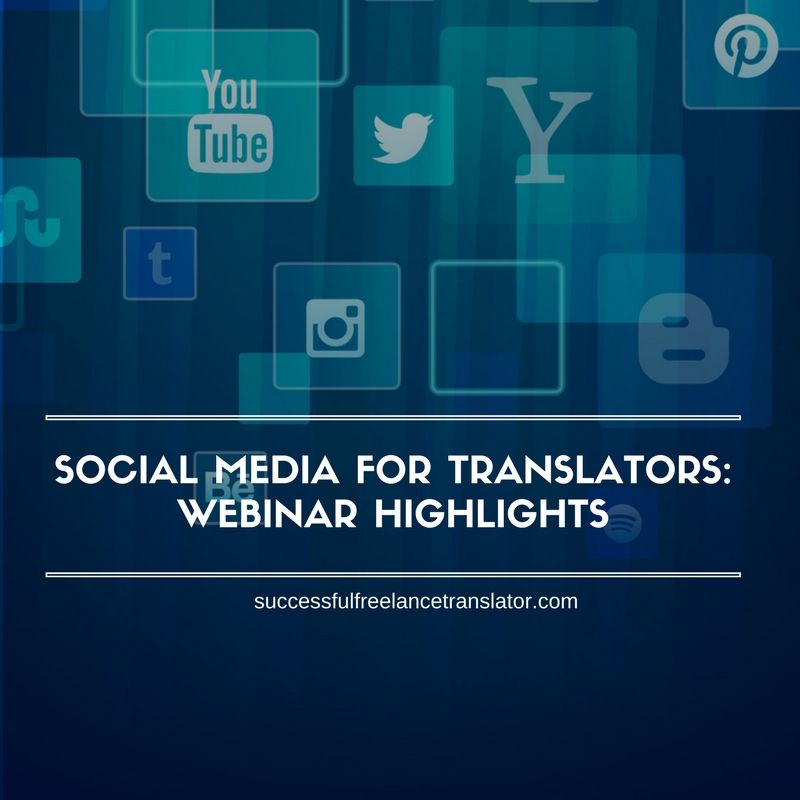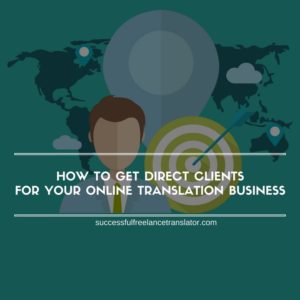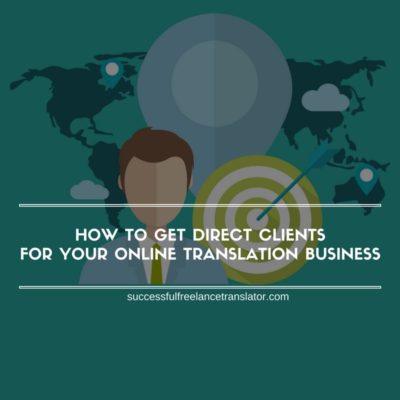Social media is a powerful communication and information distribution tool that cannot and shouldn’t be avoided by modern businesses, whether it is a company or an independent freelance business. Billions of people are using social networks every day and you can take advantage of social media channels for the development of your personal translation business.
What is the purpose of social media?
The main purpose of social media is communication and distribution of information.
Probably you think of social media as a tool to sell your services. But the true potential of social media spreads far beyond marketing and selling. You can learn new things, acquire new skills, connect with people you could never meet before and help other users to resolve their problems.
But the first and the main purpose of social media when it is used as a marketing channel is to let people know about your existence.
Two main approaches to getting new clients on social media
People use social media as a source of information, and no one uses them just to look at beautiful ads. Therefore, in the first instance, we should use social media as a tool to share valuable information that can be helpful for our potential clients. This approach is called “inbound marketing” — when you help your potential clients find you. You shall try to lead the prospect through the sales funnel that, in this case, starts on social media where a customer finds a content that seems to answer his questions and, ideally, ends on your website where the customer fills in a contact form with a translation request. This sales funnel can be reduced to social media only, when your customer finds relevant information, looks through your business page and contacts you directly through a message on Facebook, Twitter of LinkedIn.
Another approach is called “outbound marketing”. The main purpose of outbound marketing is to reach out to your potential clients without waiting when they find you.
Now there is another question: what can you do to help the customers find you and to reach out to them on the social media?
[Tweet “Learn how to help the customers find you on the social media!”]
Here is what you can do:
- Create business page
- Regularly publish content
- Repost content from other resources
- Like and follow the pages of your potential clients
- Post comments
- Connect with translators
- Connect with industry leaders and other opinion leaders
- Join specialized groups
- Take active part in the group activities
The key to success on social media is simple — you should create a plan and consistently follow it. To do that, you will need a strategy.
How to develop a strategy for your social media marketing?
Developing a comprehensive strategy is a dynamic process. That means your strategy shall be flexible and alterable depending on current conditions.
My overall marketing strategy can be represented in a simple process cycle. It includes six stages:
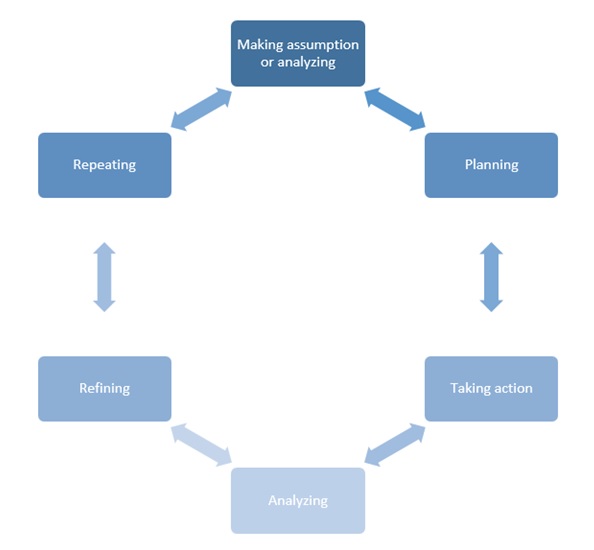
Making assumption or analyzing
First, you should identify your target audience. In other words, you have to create a customer profile. Without it, all your efforts will have zero effect. If you don’t have clients yet, make an assumption. If you have clients, analyze them. In both cases you should try to find the answer to the following questions:
- What is the physical location of your clients: country, state, city?
- What are they doing: industry, sub-industry, product, service?
- Who are your clients: position in the company, age, gender, interests?
- What is the category of your customer?
- Need translation and already has a provider
- Need translation and is searching for providers
- Does not know that he needs translation (but he actually may need it)
- How can you reach them (channels): Facebook, Twitter, LinkedIn?
Planning
When you identified your customer and found the channels, you can start planning your approach.
In short, the plan shall include the following:
- What kind of content will you publish/share?
- How will you find/create the content?
- How often will you post it?
- On which social channels?
Taking action
Now that you have developed a plan, you can start implementing it.
- Find and create relevant content,
- Publish and share,
- Engage with prospects and colleagues
Analyzing
Analyzing your performance is very important. This way you can identify the productivity of your efforts by channels and select the most effective channel among others.
Analysis tools:
Facebook Insights => Go to your business page and select Insights tab

Twitter Analytics => Click you profile image in the top bar and select Analytics from drop-down menu

LinkedIn => Hoover your mouse over Profile menu item and click Who’s viewed your profile.

For company page => Hoover your mouse over your profile image in the top menu, select Company page, go to Analytics tab.
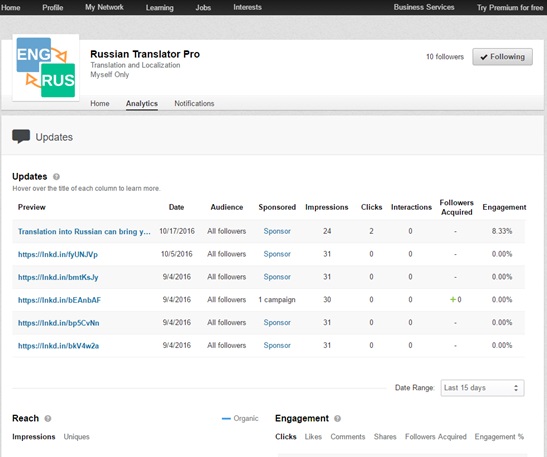
You can also use Buffer analytics to track activity related to your posts on all social networks you use.
This way you can identify what type of posts receive more attention of your subscribers and focus your further content plan on this type of content. In addition, you can measure the effectiveness of a channel. It will differ depending on your specialization.
- Metrics to define channel efficiency: engagements, comments, clicks.
- Number of engagements: shares, likes, retweets
- Number of comments (to identify discussion stimulating topics)
- Number of clicks (website visits from social media post)
- Metrics to omit during estimation: number of followers.
Remember, it is better to have 100 followers who watch your updates, like and share your posts, rather than having 1K fans who never react on your content.
At some point, you will be able to understand if you need a certain channel or not. But before quitting a channel you should think about the following: it can happen that your assumption was wrong and you cannot reach potential clients using your current approach.
Reasons, why your strategy does not work, may include:
- Targeting the wrong audience
- Publishing irrelevant content
- Wrong posting time
If you realigned the strategy and it still does not bring your good results, you can leave this channel and stop spending your time on it.
Refining and Repeating
After a month of active SMM promotion you will be able to see the main trends on your channels: what types of posts are the most engaging, what people like, what they share, what they don’t like and never share, etc. Monthly statistics will either prove your assumption or disprove it. Based on the analysis you can decide if you would like to continue with this channel or leave it and test another approach.
Using this “Refine and Repeat” process forming an SMM Strategy you will finally find the right approaches to your ideal customers.
How many social networks should you use?
There is no direct answer for this question. Some marketers suggest to use as many networks as you can to cover large audience, others suggest to focus on one social network. However, I would recommend to start with 4 networks (Facebook, Twitter, LinkedIn, Google+) and then identify the best channels using the above-motioned cycle. This way you can select the most efficient channels and focus on them only.
Which social media platforms are the most useful for freelance translators?
Everything depends on your target audience. You should select networks based on your potential customer profile. Let’s take three areas where people and companies may need translation: tourism, software development, legal advice.
Tourism: tour operators use Instagram, Facebook, Pinterest and probably Twitter. These networks offer a great opportunity to attract visitor using visuals content such as images and videos.
Software developers: you should definitely use Twitter and Facebook to reach them. Take a random software developer company and I’m sure you find their Twitter profile at least. I know many software companies who use social media to render support services to their users.
Law firms: LinkedIn, Facebook. More conventional industries that existed before the Internet tend to use professional networks such as LinkedIn. Facebook sometimes is also used to inform their customers about company updates or something similar.
What are people looking for on different social media
LinkedIn: an audience of professionals. Think about how your piece of content can add value to the professional lives of your audience.
Facebook: an audience is looking for entertainment and value. Think, about “shares” first. What will make your audience want to share your post? Try to attract interest with captions and headlines.
Twitter: an audience is looking for news, tips, how-to’s, interesting articles, and what’s trending. Focus on short and eye-catching titles for your Twitter posts.
Personal account vs Business account. Is it worth to have both?
Yes, it is worth having both. And acutely you should have both on Facebook. This way you can control your privacy and separate business matters from friends, family, and entertainment.
It also depends on the network. In the case of LinkedIn, your personal profile is already a business profile, where you place information about your experience, achievements, skills, projects, videos, etc. You can even use LinkedIn publisher tool to share posts right at LinkedIn. However, you can also create a business page that offers better analytical and promotion opportunities in comparison to a personal profile.
In the case of Twitter, I don’t think it’s a good idea to distinguish between business and personal profile. But if you’re a Twitter lover and post several times a day about your daily routine, it is better to create a new profile for business. To manage multiple accounts you can use Twitter Deck service.
How to attract direct clients on Facebook without too much engaging in paid advertising?
Let me be honest, it is not easy to achieve good results on Facebook without paid ads. I guess this is a Facebook policy – they need to make money from ads. They frequently change news feed algorithms and the post coverage depends on many factors, including the number of fans on your page. Before you reach 1K fans about 1/3 of your subscribers will see your updates. As soon as you reach 1000, only 1/4 or even less of your page subscribers will see your updates. The larger the audience, the fewer people will see your updates.
How to improve that? The only possible way to increase organic reach is to post high-quality, useful and engaging content. The approximate scheme for content sharing is as follows:
- 20% of promotion content (you advertise your services),
- 60% of curated content (pictures, tips & tricks, videos)
- 20% of your own client-education content (blog posts, videos, presentations, infographics).
How to promote yourself via Twitter or Instagram?
First of all, you need to determine the goal. Why do you want to promote your Twitter or Instagram profiles? Who are you going to target at?
The best simple tactics to promote your Twitter and Instagram profiles from the day one is to follow other users, like or retweet their content. These networks seem to work on mutual likes and followers.
Twitter and Instagram suggest new contacts, you can follow 1-3 new people daily, share and like their updates, leave comments and you will see how your followers count increases day by day.
Of course, you should carefully select whom to follow. As I mentioned above, the number of followers means nothing without engagement.
[Tweet “Number of followers means nothing without engagement. Learn how to optimize your SMM efforts!”]
Also, the following methods can be applied for any of social networks.
- Include a link to your social profile in the email signature.
- Add links to your social profiles on your website.
- Invite your existing clients to follow your profiles via email newsletter.
- Cross-post invitation on different networks: ask you Twitter followers to join your Facebook page and vice versa.
Which social media manager would you recommend?
I have tried HootSuite and Buffer. The first one is a really complex tool designed primarily for SMM managers and companies, rather than for individual use. Buffer, on the other side, offers a good balance between personal and company plans both in terms of free and paid options.
I did not like HootSuite due to overloaded interface and multiples features I actually don’t’ need. Therefore, I decided to stay with Buffer and now I’m using a paid plan called “Awesome”. It costs about 100 bucks per year. If you are limited with your budget, you can start with a free plan that offers 5 platforms to connect and 10 posts to schedule per profile. With the “Awesome” plan you get 10 platforms and 100 posts to schedule at a time. 100 posts it is about a full month of SMM calendar with 3 posts per day — more than enough for a personal small business.

